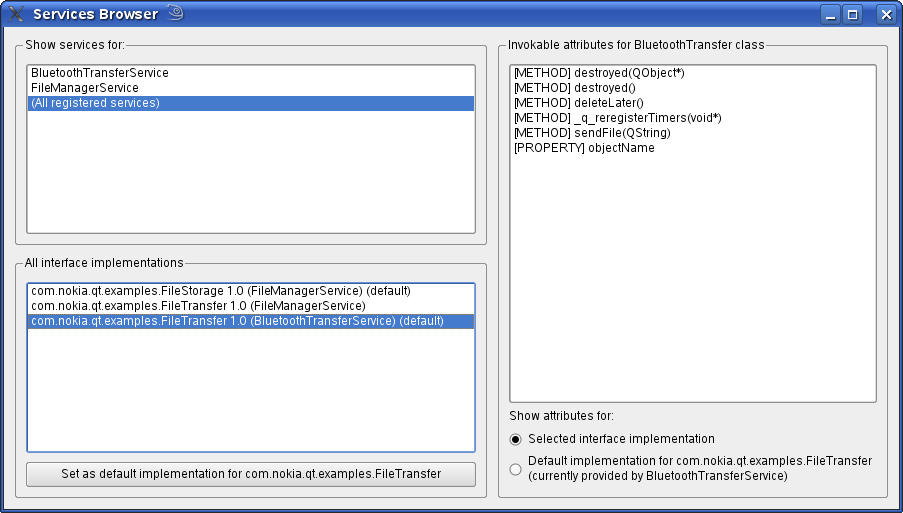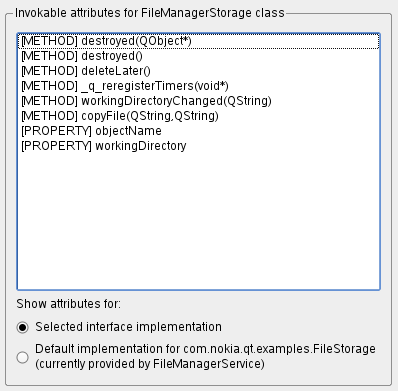
Files:
This example shows how to use the Service Framework to:

The application window is split into three panes.
The top-left pane shows all the services that are registered within the Service Framework. For this example, the filemanagerplugin and bluetoothtransferplugin services included in the examples/ directory have been registered, and so are visible in this pane.
The bottom-left pane shows the interfaces implemented by the service selected in the top-left pane. Each entry in this list shows:
The right-hand pane shows the attributes of an interface implementation that are invokable through the Qt meta-object system. Such attributes include signals, slots, properties and methods marked with the Q_INVOKABLE macro. If the "Selected implementation" radio button is checked, this view shows the attributes of the selected implementation in the bottom-left pane; otherwise, it shows the attributes of the default implementation for the interface of the selected implementation.
The ServiceBrowser class inherits from QWidget. It has several slots for reloading the lists in the three information panes, and for changing the default implementation for an interface.
class ServiceBrowser : public QWidget { Q_OBJECT public: ServiceBrowser(QWidget *parent = 0, Qt::WindowFlags flags = 0); ~ServiceBrowser(); private slots: void currentInterfaceImplChanged(QListWidgetItem *current, QListWidgetItem *previous); void reloadServicesList(); void reloadInterfaceImplementationsList(); void reloadAttributesList(); void setDefaultInterfaceImplementation(); private: ... };
ServiceBrowser::ServiceBrowser(QWidget *parent, Qt::WindowFlags flags) : QWidget(parent, flags) { serviceManager = new QServiceManager(this); systemManager = new QServiceManager(QService::SystemScope); registerExampleServices(); initWidgets(); reloadServicesList(); setWindowTitle(tr("Services Browser")); }
The constructor registers the "FileManagerService", "BluetoothTransferService" and "NotesManagerServices" services that are provided by the filemanagerplugin and bluetoothtransferplugin projects in the examples/ directory. It also calls reloadServicesList() to show these two newly registered services in the top-left pane.
void ServiceBrowser::reloadServicesList() { servicesListWidget->clear(); QSet<QString> services; QList<QServiceInterfaceDescriptor> descriptors = serviceManager->findInterfaces(); for (int i=0; i<descriptors.count(); i++) { QString service = descriptors[i].serviceName(); if (descriptors[i].scope() == QService::SystemScope) service += tr(" (system)"); services << service; }
When the services list in the top-left pane needs to be refreshed, we call QServiceManager::findServices() to get a QStringList of all services that are currently registered with the service framework.
void ServiceBrowser::reloadInterfaceImplementationsList() { ... ... QList<QServiceInterfaceDescriptor> descriptors = manager->findInterfaces(serviceName); attributesListWidget->clear(); interfacesListWidget->clear(); for (int i=0; i<descriptors.count(); i++) { if (descriptors[i].scope() != manager->scope() && !serviceName.isEmpty()) continue; QString text = QString("%1 %2.%3") .arg(descriptors[i].interfaceName()) .arg(descriptors[i].majorVersion()) .arg(descriptors[i].minorVersion()); QServiceInterfaceDescriptor defaultInterfaceImpl = manager->interfaceDefault(descriptors[i].interfaceName()); if (serviceName.isEmpty()) { text += " (" + descriptors[i].serviceName() + ")"; if (descriptors[i].scope() == QService::SystemScope) { text += tr(" (system"); defaultInterfaceImpl = systemManager->interfaceDefault(descriptors[i].interfaceName()); if (descriptors[i] == defaultInterfaceImpl) text += tr(" default)"); else text += ")"; defaultInterfaceImpl = QServiceInterfaceDescriptor(); } ... }
To create the list of interface implementations in the bottom-left pane, we call QServiceManager::findInterfaces() to get a list of QServiceInterfaceDescriptor objects. If a particular service has been selected in the top-left pane, we call QServiceManager::findInterfaces() with the name of that service as the argument, so that it will only return the interface implementations provided by that service. Otherwise, it is called with no argument to retrieve a list of all implementations provided by all registered services.
The example maps each entry in the interface implementations list to its corresponding QServiceInterfaceDescriptor object using the QListWidgetItem::setData() method.
Note how we also call QServiceManager::defaultServiceInterface() to determine whether an interface implementation is the default for that interface.
void ServiceBrowser::reloadAttributesList() { QListWidgetItem *item = interfacesListWidget->currentItem(); if (!item) return; QServiceInterfaceDescriptor selectedImpl = item->data(Qt::UserRole).value<QServiceInterfaceDescriptor>(); QObject *implementationRef; if (selectedImplRadioButton->isChecked()) implementationRef = serviceManager->loadInterface(selectedImpl, 0, 0); else implementationRef = serviceManager->loadInterface(selectedImpl.interfaceName(), 0, 0); ...
The reloadAttributesList() method creates the list in the right-hand pane that shows the attributes of an interface implementation that can be invoked through the Qt meta-object system.
QServiceManager::loadInterface() is called to get an instance of the identified interface implementation. This method finds the corresponding service plugin and returns the QObject instance provided by the service plugin's QServicePluginInterface::createInstance() method.
...
const QMetaObject *metaObject = implementationRef->metaObject();
attributesGroup->setTitle(tr("Invokable attributes for %1 class")
.arg(QString(metaObject->className())));
for (int i=0; i<metaObject->methodCount(); i++) {
QMetaMethod method = metaObject->method(i);
attributesListWidget->addItem("[METHOD] " + QString(method.signature()));
}
for (int i=0; i<metaObject->propertyCount(); i++) {
QMetaProperty property = metaObject->property(i);
attributesListWidget->addItem("[PROPERTY] " + QString(property.name()));
}
}
Call QObject::metaObject() on the implementation instance to get a QMetaObject instance that reveals the dynamically invokable attributes for the instance. These attributes include properties, signals, slots, and methods marked with the Q_INVOKABLE macro. Call QMetaObject::method() to get information about a signal, slot or invokable method, and QMetaObject::property() to access a property of the instance.
When you know the name of the method you wish to invoke, call QMetaObject::invoke() or QMetaMethod::invoke() to invoke it dynamically. Similarly, QMetaProperty::read() and QMetaProperty::write() can be used to read and modify the value of a property.
Here is an example of invoking attributes on an implementation, using the FileManagerPlugin that is shown in the Service Browser.
The FileManagerPlugin provides a service called "FileManagerService" in its filemanagerplugin.xml service definition. When FileManagerPlugin::createInstance() is called, if the com.nokia.qt.examples.FileStorage interface is requested, it returns an instance of the FileManagerStorage class. The FileManagerStorage class is defined like this:
class FileManagerStorage : public QObject { Q_OBJECT Q_PROPERTY(QString workingDirectory READ workingDirectory WRITE setWorkingDirectory) public: FileManagerStorage(QObject *parent = 0); void setWorkingDirectory(const QString &path); QString workingDirectory() const; signals: void workingDirectoryChanged(const QString &newDir); public slots: void copyFile(const QString ¤tPath, const QString &newPath); private: QString directory; };
So if, in the ServiceBrowser application, we select the com.nokia.qt.examples.FileStorage implementation provided by FileManagerService, the browser would display all the dynamically invokable attributes of the FileManagerStorage class:

As you can see, the FileManagerStorage::workingDirectory property, the FileManagerStorage::copyFile() slot and the FileManagerStorage::workingDirectoryChanged() signal are all listed. (The destroyed(), deleteLater() and _q_reregisterTimers() attributes are inherited from the QObject parent.)
To invoke the copyFile() slot, for example:
QObject *interfaceImpl = QServiceManager::loadInterface("com.nokia.qt.examples.FileStorage", 0, 0); QMetaObject::invokeMethod(interfaceImpl, "copyFile", Q_ARG(QString, "path/to/file.txt"), Q_ARG(QString, "new/path/to/file.txt"));
Of course, the QServiceManager::loadInterface() call here assumes the FileManagerStorage implementation is the default for the com.nokia.qt.examples.FileStorage interface. Otherwise, it would have to pass a QServiceInterfaceDescriptor object to QServiceManager::loadInterface() instead of just the interface name to ensure the correct implementation is loaded.
© 2008-2011 Nokia Corporation and/or its subsidiaries. Nokia, Qt and their respective logos are trademarks of Nokia Corporation in Finland and/or other countries worldwide.
All other trademarks are property of their respective owners. Privacy Policy
Licensees holding valid Qt Commercial licenses may use this document in accordance with the Qt Commercial License Agreement provided with the Software or, alternatively, in accordance with the terms contained in a written agreement between you and Nokia.
Alternatively, this document may be used under the terms of the GNU Free Documentation License version 1.3 as published by the Free Software Foundation.




